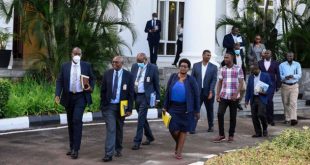Major projects underway
Significantly, the oilfields FEED launch happened just five weeks after the FEED study for the crude oil export pipeline from Uganda’s oilfields to the Tanzanian port of Tanga got underway on Jan.9.
Officials from the governments of Uganda, Tanzania and the three oil firms jointly launched the FEED study for Uganda’s 1450km-long crude oil pipeline being done by the US-based Gulf Interstate Engineering (GIE) at a cost of $11.5m. The study completion deadline is August.
Concurrent with the FEED studies, are the Environmental and Social Impact Assessment (ESIA) and Land acquisition and Resettlement Planning (LARP) studies.
The two oilfields under development are EA1 at the northern tip of Lake Albert within Murchison Falls National Park and EA2 which is to the east of Lake Albert in Buliisa District. Both oilfields are now operated by the French oil major subsidiary, Total E&P Uganda.
The FEED studies are being done by three companies at a cost of $2.5 million each. The companies are Fluor, a French firm which is partnering with the China Petroleum Engineering Construction Corporation (CPECC), Technip, another French firm, and Chicago Bridge & Iron Company (CB&I) based in the United States of America.
The three companies are expected to produce designs for facilities that will process about 200,000 barrels of oil at a Central Processing Facility (CPF).
A CPF refers to a unit where crude oil is first stored for stabilisation and treatment before being fed into either the refinery or crude oil export pipeline. Under this facility, crude oil from underground the oil field is moved to the processing component where the oil, gas, water and well fluids are separated. It also has production pipelines which are used to transport the already produced oil and gas. From the CPF, the oil is either sent to a refinery or a crude export pipeline.
This CPF is expected to be built on a clearing measuring 1.5km by 2km in Buliisa District. A second CPF is also expected to be established in the EA-3 Kingfisher area and will be much smaller, with a capacity to process just 30,000bpd. The studies will also include design studies for feeder pipelines that will evacuate crude oil from Kingfisher which is found in Kaiso Tonya and nearby oil wells to the planned CPF in Hoima District.
A fast-tracking mechanism has been embedded even within the FEED stage. Adewale Fayemi, the General Manager of Total E&P Uganda who spoke throughout the signing ceremony on behalf of the joint venture partners said the contracts of the three firms are under a “competitive FEED”.
“As the contractual strategy chosen is a competitive FEED, after six months of initial design, the two best performing companies on the FEED contract shall be invited to compete for EPC.”
Adewale said at the end of the year, the joint venture oil company partners should be in position to say, “We have a contractor that is going to execute the design for the CPF.”
He said the three companies would have to incorporate the Engineering Procuring & Construction (EPC) in their studies to kill two birds with one stone.
“We will get more than FEED because we intend to get the company that will execute the EPC contract to be chosen among these three companies,” he said.
He said up to 36 well pads and about 400 oil wells are expected to be drilled, and trunk lines measuring a total of 200 km from the well pads onto the CPF are expected to be set up.
Adewale said all the companies boast of invaluable experience in the design and construction of remote onshore projects elsewhere in the world, and are bringing different engineering design philosophies and expertise for the benefit of the project.
 The Independent Uganda: You get the Truth we Pay the Price
The Independent Uganda: You get the Truth we Pay the Price


